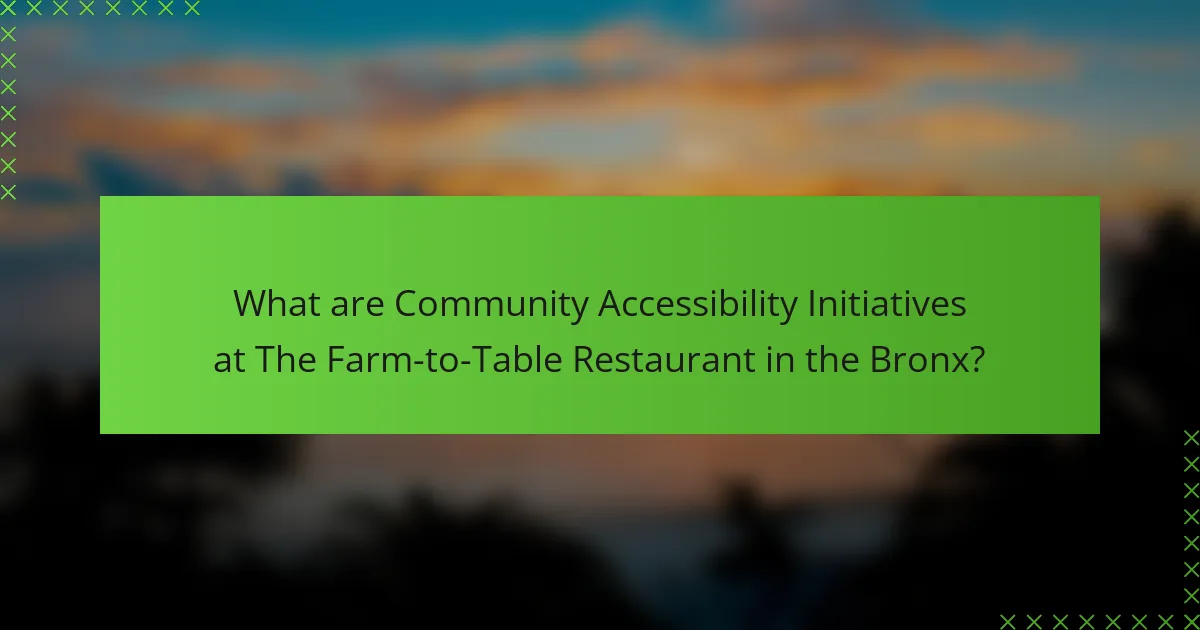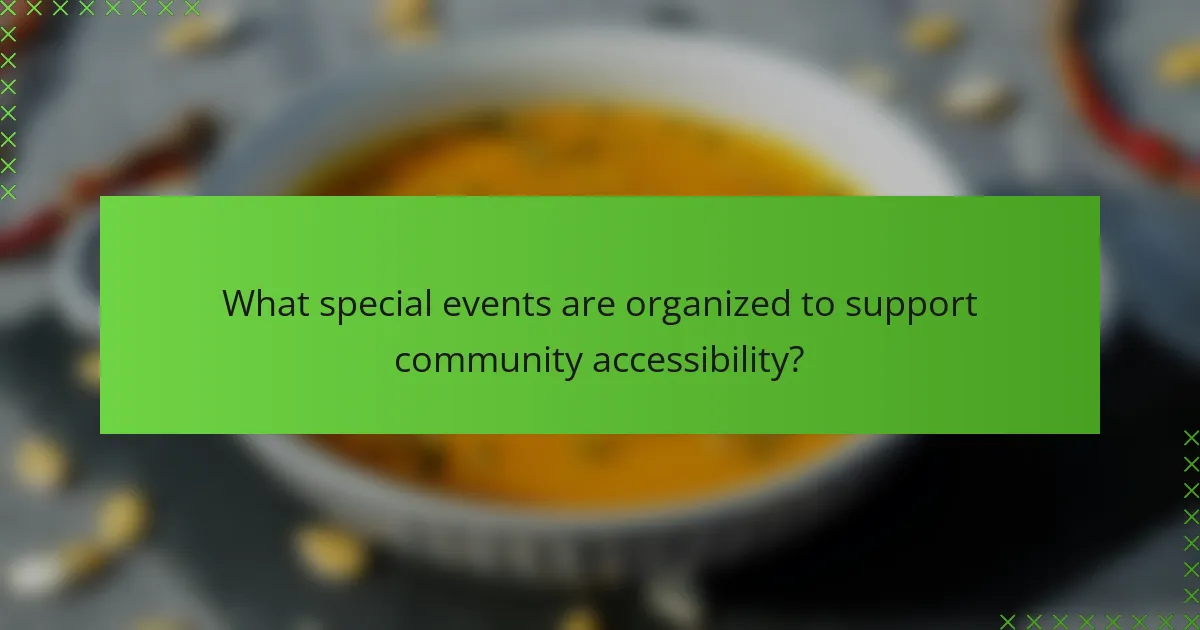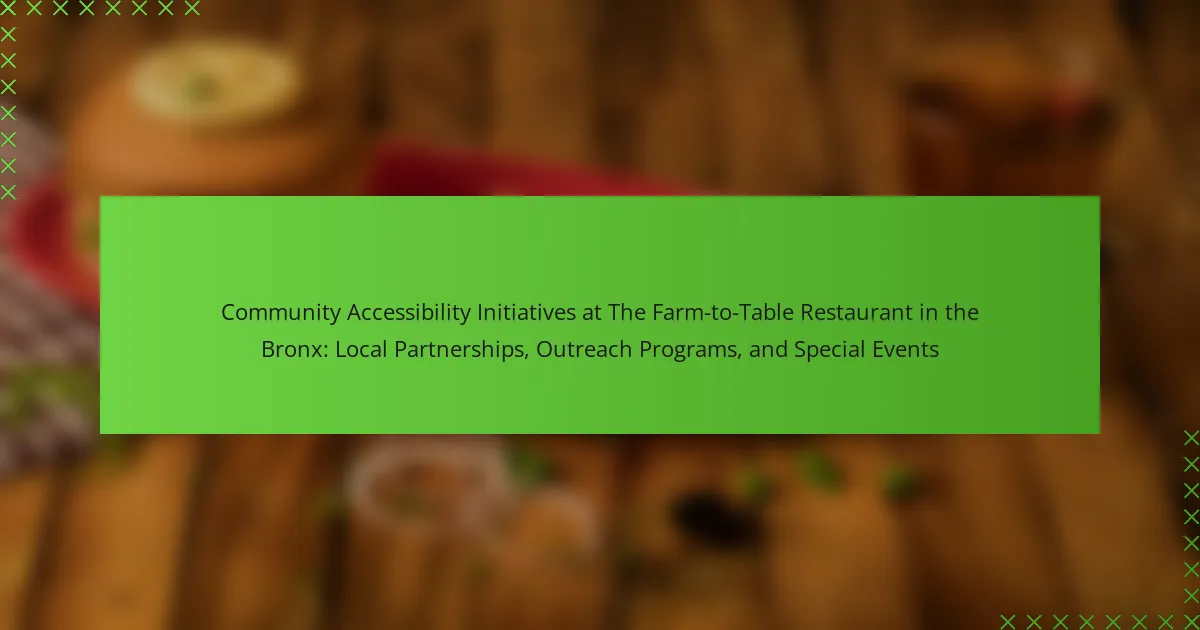
What are Community Accessibility Initiatives at The Farm-to-Table Restaurant in the Bronx?
The Farm-to-Table Restaurant in the Bronx implements several community accessibility initiatives. These initiatives focus on enhancing access to fresh, locally sourced food. The restaurant collaborates with local farms to provide affordable produce. It also conducts outreach programs to educate the community about nutrition. Special events are organized to promote awareness of food accessibility issues. The restaurant partners with local organizations to support underserved populations. These efforts aim to foster a healthier community. Statistics show that such initiatives can significantly improve local food security.
How do these initiatives enhance local community engagement?
These initiatives enhance local community engagement by fostering connections among residents. They create opportunities for collaboration between the restaurant and local organizations. Outreach programs invite community members to participate in events. Special events promote cultural exchange and awareness of local issues. Partnerships with schools and nonprofits encourage educational activities. The initiatives also provide platforms for local artists and businesses to showcase their work. Research indicates that such community-focused activities increase social cohesion. A study by the National Endowment for the Arts found that community engagement initiatives improve neighborhood satisfaction and well-being.
What specific goals do these initiatives aim to achieve?
The specific goals of the community accessibility initiatives at the Farm-to-Table Restaurant in the Bronx include increasing local food access. These initiatives aim to engage underserved populations in healthy eating. They also strive to foster partnerships with local organizations for broader outreach. Another goal is to promote sustainable food practices within the community. Enhancing awareness of nutritional education is also a key objective. These initiatives seek to build a sense of community through special events and programs. They ultimately aim to improve overall community health and well-being.
How do these initiatives reflect the values of the restaurant?
The initiatives reflect the restaurant’s values by promoting community engagement and sustainability. They foster local partnerships, which align with the restaurant’s commitment to sourcing ingredients from nearby farms. Outreach programs enhance food accessibility, demonstrating a dedication to serving diverse community needs. Special events often focus on educating patrons about healthy eating and local agriculture, reinforcing the restaurant’s mission. These efforts show a commitment to social responsibility and environmental stewardship, key values of the establishment. The restaurant’s actions illustrate a holistic approach to community involvement and support for local economies.
Why are local partnerships important for these initiatives?
Local partnerships are crucial for community accessibility initiatives. They enhance resource sharing among stakeholders. Collaborative efforts increase outreach effectiveness to diverse populations. Local partnerships foster trust and engagement within the community. They provide valuable insights into community needs and preferences. This collaboration can lead to tailored programs that address specific barriers. Evidence shows that initiatives with local partnerships experience higher participation rates. For instance, a study by the Community Food Security Coalition highlights increased access to fresh food through local collaborations.
What types of local organizations does the restaurant partner with?
The restaurant partners with various local organizations. These include community food banks, local farmers, and educational institutions. The partnerships aim to enhance food accessibility and promote sustainable practices. Collaborations with food banks help address hunger in the Bronx. Working with local farmers supports the farm-to-table concept. Educational institutions are involved in outreach programs that teach cooking and nutrition. These partnerships foster community engagement and support local economies.
How do these partnerships benefit both the restaurant and the community?
Partnerships benefit both the restaurant and the community by fostering mutual support and resource sharing. Restaurants gain access to local ingredients, enhancing their menu quality. This connection promotes sustainability and supports local farmers. Communities benefit from increased access to fresh food options. Local partnerships often lead to educational programs about nutrition and cooking. These initiatives can also create job opportunities within the community. Events organized through partnerships encourage community engagement and social interaction. Overall, such collaborations strengthen local economies and enhance community well-being.

What outreach programs are implemented by The Farm-to-Table Restaurant?
The Farm-to-Table Restaurant implements several outreach programs focused on community engagement. These programs include partnerships with local farms to promote sustainable agriculture. They also host educational workshops on nutrition and cooking. Additionally, the restaurant collaborates with schools to provide healthy meal options. Community events are organized to raise awareness about food accessibility. These initiatives aim to strengthen local food systems and support underserved populations. Evidence of their impact includes increased community participation in healthy eating programs.
How do these outreach programs promote accessibility?
Outreach programs promote accessibility by providing resources and support to underserved communities. They offer educational workshops to inform individuals about available services. These programs also facilitate partnerships with local organizations to enhance community engagement. By creating inclusive events, they encourage participation from diverse groups. Accessibility is further improved through transportation assistance for those with mobility challenges. Additionally, outreach initiatives often include language support for non-English speakers. These efforts ensure that all community members can access resources and participate fully.
What are the key components of these outreach programs?
The key components of outreach programs include community engagement, resource distribution, and educational initiatives. Community engagement fosters relationships between the restaurant and local residents. Resource distribution ensures access to fresh produce and meals for underserved populations. Educational initiatives provide information on nutrition and cooking skills. These components work together to enhance community well-being. They promote healthier lifestyles and increase food security. Studies show that effective outreach can lead to improved community health outcomes.
How are community members involved in these programs?
Community members participate in these programs through various roles and activities. They engage in local partnerships by collaborating with the restaurant to promote accessibility initiatives. Outreach programs often include workshops where community members can share their insights and needs. Special events are organized to foster community involvement, allowing members to contribute ideas and feedback. Volunteers from the community help in executing these initiatives, providing hands-on support. Surveys and community meetings gather input from residents to shape the programs effectively. This collaborative approach ensures that the initiatives reflect the community’s values and priorities.
What challenges do outreach programs face?
Outreach programs face various challenges that hinder their effectiveness. Limited funding restricts the scope and reach of these initiatives. Insufficient community engagement can lead to low participation rates. Language barriers may prevent effective communication with diverse populations. Additionally, logistical issues, such as transportation and scheduling, complicate program implementation. Evaluating impact remains difficult due to a lack of measurable outcomes. Lastly, competing priorities within communities can divert attention and resources away from outreach efforts. These challenges collectively undermine the goals of outreach programs.
How does the restaurant address these challenges?
The restaurant addresses these challenges through strategic local partnerships and outreach programs. It collaborates with local farms to ensure fresh produce is available. This partnership enhances food quality while supporting local agriculture. The restaurant also hosts community events to raise awareness about healthy eating. These events engage residents and promote accessibility to nutritious food options. Additionally, the restaurant offers discounts for low-income families. This initiative ensures that cost does not hinder access to healthy meals. The combination of these efforts effectively tackles the challenges of community accessibility.
What feedback has been received from the community regarding these programs?
Community feedback regarding the accessibility initiatives at The Farm-to-Table Restaurant in the Bronx has been largely positive. Many local residents appreciate the outreach programs that promote inclusivity. Participants have expressed satisfaction with the partnerships formed with local organizations. Feedback highlights the importance of accessible events for diverse community members. Some community members noted improvements in food access and education. They reported feeling more connected to the restaurant and its mission. Additionally, surveys indicated a desire for continued engagement and more events. Overall, the community values these programs and their impact on local accessibility.

What special events are organized to support community accessibility?
The Farm-to-Table Restaurant in the Bronx organizes various special events to support community accessibility. These events include accessibility awareness days, where the restaurant showcases its commitment to inclusivity. Workshops on adaptive cooking techniques are also held, allowing individuals with disabilities to participate actively. Community dinners feature accessible menus tailored for diverse dietary needs. Additionally, partnerships with local organizations facilitate events focused on mobility and transportation solutions. These initiatives aim to enhance community engagement and ensure everyone can enjoy the restaurant’s offerings.
How do these events foster inclusivity?
These events foster inclusivity by creating accessible spaces for diverse community members. They provide opportunities for engagement among various cultural groups. Events often feature activities that cater to different interests and backgrounds. This encourages participation from individuals who might otherwise feel marginalized. Collaborations with local organizations enhance outreach to underrepresented populations. Programs are designed to be family-friendly and welcoming to all ages. Feedback from community members is actively sought to improve future events. This approach ensures that the events reflect the needs and desires of the community, fostering a sense of belonging.
What types of special events are held throughout the year?
The Farm-to-Table Restaurant in the Bronx hosts various special events throughout the year. Seasonal festivals celebrate local harvests and promote community engagement. Educational workshops focus on sustainable practices and cooking techniques. Fundraising events support local charities and outreach programs. Holiday celebrations bring together the community for festive meals. Collaborative events with local farms highlight fresh produce. Pop-up markets showcase local artisans and crafts. Each event aims to enhance community accessibility and awareness of local food systems.
How are these events promoted to the local community?
Events at the Farm-to-Table Restaurant in the Bronx are promoted through various outreach strategies. The restaurant collaborates with local organizations to spread the word. Flyers and posters are distributed in community centers and local businesses. Social media platforms are utilized to reach a wider audience. Email newsletters are sent to subscribers highlighting upcoming events. Local press releases are issued to inform the media and community. Word-of-mouth promotion occurs through satisfied attendees sharing their experiences. These methods ensure effective communication with the local community.
What impact do these events have on community relationships?
Events at the Farm-to-Table Restaurant strengthen community relationships. They foster connections among local residents and businesses. These gatherings encourage collaboration and support within the community. Participation in events often leads to increased trust and understanding. For instance, shared meals promote cultural exchange and inclusivity. Additionally, outreach programs enhance community engagement and awareness. This interaction builds a sense of belonging among participants. Overall, such events create a positive impact on community cohesion and solidarity.
How do attendees benefit from participating in these events?
Attendees benefit from participating in these events by gaining access to fresh, locally sourced food. They experience hands-on learning about sustainable farming practices. These events promote community engagement and foster social connections among residents. Attendees also receive educational resources on nutrition and cooking. Research indicates that community events like these improve local food security. Participating in such initiatives can enhance attendees’ overall well-being and health. Additionally, these events support local farmers and businesses, strengthening the local economy. Overall, attendees leave with valuable knowledge and a sense of community belonging.
What metrics are used to measure the success of these events?
Metrics used to measure the success of community accessibility initiatives include attendance numbers, participant feedback, and community engagement levels. Attendance numbers reflect the reach and interest of the events. Participant feedback provides insights into satisfaction and areas for improvement. Community engagement levels can be assessed through social media interactions and partnerships formed. These metrics help evaluate the effectiveness of outreach programs and local partnerships.
What are best practices for implementing community accessibility initiatives?
Best practices for implementing community accessibility initiatives include conducting thorough needs assessments. This helps identify specific barriers faced by community members. Engaging with local stakeholders ensures that initiatives are relevant and effective. Training staff on accessibility standards promotes an inclusive environment. Collaborating with organizations specializing in accessibility provides valuable insights and resources. Regularly soliciting feedback from the community helps refine initiatives. Monitoring and evaluating the impact of accessibility efforts ensures continuous improvement. Research indicates that inclusive practices lead to higher community engagement and satisfaction.
The main entity of the article is the Farm-to-Table Restaurant in the Bronx, which implements community accessibility initiatives to enhance access to fresh, locally sourced food. The article outlines the restaurant’s partnerships with local farms and organizations, its outreach programs focused on nutrition education, and special events designed to promote inclusivity and community engagement. Key goals include increasing food access for underserved populations, fostering sustainable practices, and building community relationships through collaborative efforts. The article also addresses challenges faced by these initiatives and highlights metrics for measuring their success, emphasizing the importance of local partnerships and community involvement.
